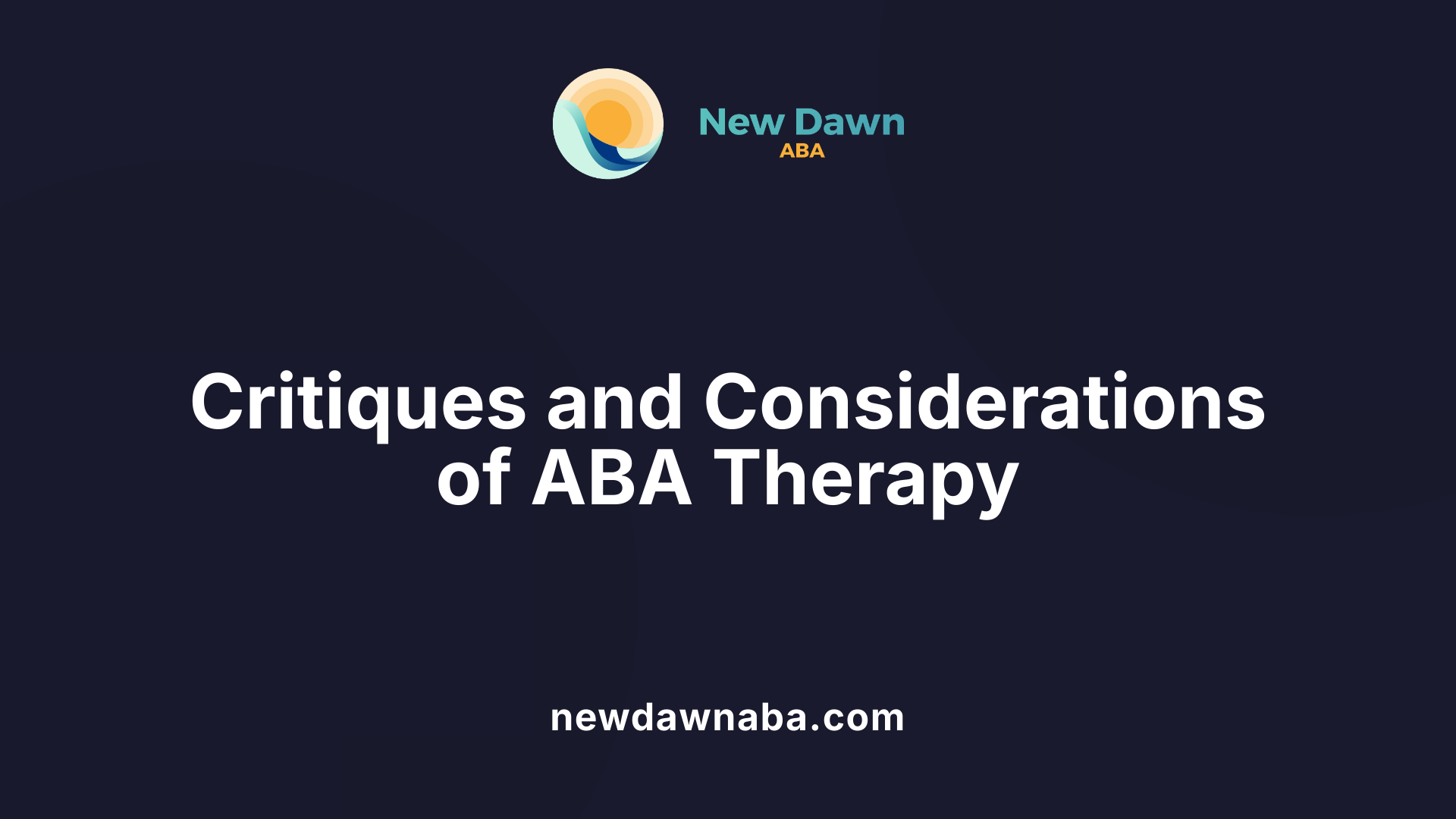Understanding ABA Therapy and Its Impact
Applied Behavior Analysis (ABA) therapy is a research-backed approach designed to enhance the development of essential skills and reduce problematic behaviors in individuals with autism. As a cornerstone of therapeutic programs, ABA focuses on understanding the interplay between behavior and the environment, and its methodologies have become integral to autism development programs worldwide. This narrative explores the principles, methodologies, and impacts of ABA therapy in supporting children with autism.
Key Facts about ABA Therapy

- Applied Behavior Analysis (ABA) is a scientifically-backed method to modify behavior through understanding environmental influences.
- Current Practices emphasize positive reinforcement and the A-B-C model (Antecedent, Behavior, Consequence) for effective behavior analysis.
- ABA benefits children with autism by improving language, social interaction, daily living skills, and academic performance.
- Typically, ABA therapy lasts 2-3 years, requiring 25 to 40 hours of weekly sessions for effective development, particularly if commenced before age four.
- Key factors influencing ABA therapy duration include individual needs, therapy progress, family involvement, and skill generalization.
- Common ABA methodologies include Discrete Trial Training (DTT), Pivotal Response Treatment (PRT), and Natural Environment Teaching (NET) for tailored learning.
- ABA therapy extends beyond autism, effectively addressing issues related to ADHD, OCD, PTSD, and various behavioral challenges across demographics.
- Positive reinforcement is crucial in ABA, helping motivate and teach desired behaviors through rewards and effective communication techniques.
- Critics of ABA express concerns over potential emotional neglect and stress due to its intensive and repetitive nature, advocating for individualized approaches.
- Despite criticisms, ABA remains a structured, evidence-based approach known for delivering significant skill improvements when personalized and evaluated properly.
Introduction to ABA Therapy
What is Applied Behavior Analysis (ABA)?
Applied Behavior Analysis (ABA) is a scientific approach that focuses on understanding behavior and how it is influenced by the environment. It systematically applies principles of learning and behavioral strategies to teach new skills and enhance socially significant behaviors, such as communication, academic, and daily living skills. ABA aims to increase desired behaviors, teach new skills, maintain learned behaviors, and reduce challenging behaviors. The term 'applied' emphasizes targeting behaviors that have social relevance, and its principles are utilized across various settings, including education and healthcare.
Data collection and analysis play a crucial role in determining the effectiveness of interventions within ABA. Practitioners use these methods not only to track the child's progress but also to adapt the treatment to suit individual needs. This evidence-based approach ensures that the therapy remains tailored to the unique challenges and strengths of each child.
Principles of ABA
The foundational principles of ABA revolve around behavior modification through reinforcement. A core strategy is positive reinforcement, where a desirable behavior, such as completing a task, is followed by a valued reward. This encourages the likelihood of that behavior being repeated in the future.
The A-B-C model, which stands for Antecedent-Behavior-Consequence, is also central in ABA. By breaking down the components of behavior, practitioners can assess what triggers certain actions and how subsequent outcomes affect those actions. For instance:
| Antecedents | Behavior | Consequences |
|---|---|---|
| Child sees a toy | Reaches for the toy | Gets to play with the toy |
| Sounds of a bell | Looks toward the source | Learns that the bell signals snack time |
This structured method ensures behaviors are addressed effectively and can lead to substantial improvements in skills like communication and social interaction.
Benefits for Children with Autism
ABA therapy has been shown to offer numerous benefits for children with autism, enhancing various areas of development. Intensive and individualized programs often result in significant gains in:
- Language skills: Developing both verbal and nonverbal communication.
- Social skills: Improving interactions with peers and adults.
- Daily living skills: Enhancing independence through self-care tasks and functional abilities.
- Academic performance: Supporting learning in an educational environment to improve focus and attention.
Research consistently demonstrates that children who receive ABA therapy early, especially those who begin treatment before age four, experience remarkable improvements. Outcomes include better intellectual functioning and social engagement, with the most success linked to comprehensive programs that provide 20-40 hours of therapy per week. Through its data-driven practices and commitment to individualization, ABA therapy equips families and children with the tools to foster significant, meaningful changes in their lives.
Comparing ABA Therapy with Other Approaches
What is the difference between ABA and developmental therapy?
Applied Behavior Analysis (ABA) notably diverges from developmental therapy in its approach to supporting individuals with challenges. ABA is rooted in behavior modification, employing structured and repetitive tasks along with reinforcement strategies. This method is highly effective for teaching specific skills as it breaks them down into smaller and manageable steps, rewarding successful behaviors. For instance, during an ABA session, a child may learn communication skills through systematic prompting and reinforcement for correct responses.
Conversely, developmental therapy prioritizes the holistic growth of the child. It emphasizes adaptability and the development of skills through play and natural interactions rather than the stringent repetition characteristic of ABA. This approach encourages individuals to generalize skills learned in one context to real-life situations, promoting flexible thinking and problem-solving abilities.
Despite the objectives of both methodologies focusing on fostering learning and development, their styles and methods differ significantly.
ABA's unique methodologies
ABA is distinguished by its range of specific techniques tailored to meet individual needs. Common methodologies within ABA include:
- Discrete Trial Training (DTT): This involves breaking down tasks into simple steps and systematically teaching each component.
- Pivotal Response Treatment (PRT): This flexible approach encourages naturalistic teaching, leveraging a child's interests to facilitate learning.
- Natural Environment Teaching (NET): Skills are taught in the context of everyday activities, promoting practical application and retention.
One unique feature of ABA therapy is the use of the A-B-C model (Antecedent, Behavior, Consequence) to analyze behaviors. This model helps in understanding not just what behaviors are occurring, but also why and how they can be modified effectively.
In summary, while ABA focuses on structured behavior modification, developmental therapy leans towards holistic growth through play. Both approaches have their merits but serve different purposes depending on the learner's needs.
Duration and Intensity of ABA Programs

How long is ABA therapy typically recommended for autistic children?
The duration of Applied Behavior Analysis (ABA) therapy is generally intensive, with most children benefiting from about 2-3 years of therapy. This initial phase often involves receiving 25 to 40 hours of therapy each week, especially for those diagnosed at an early age. The best time to start is typically between ages 2 and 6, during which significant neural development takes place.
After this intensive phase, additional 2-3 years may be focused on refining specific skills and achieving personalized goals. This longer-term approach helps solidify learning and enables children to apply what they have acquired into their daily lives.
What factors influence the duration of ABA therapy?
The length of time a child remains in ABA therapy can vary widely based on several factors:
- Individual Needs: Each child has unique challenges and strengths that influence their therapy requirements.
- Progress: Regular assessments by a Board Certified Behavior Analyst (BCBA) can determine whether a child is ready to reduce therapy sessions. Children showing consistent progress or achieving their therapy goals may transition to less intensive support sooner.
- Family Involvement: Active participation from family members in reinforcing learned behaviors outside of therapy sessions can accelerate progress.
- Generalization of Skills: If a child can effectively apply learned skills in real-world settings, it can indicate readiness to transition out of ABA therapy.
Ongoing evaluation of these factors is essential to ensure the therapy remains beneficial and tailored to the child's evolving needs. Through careful consideration of these elements, a BCBA can create a personalized plan that balances intensity and duration for each individual child, promoting effective learning and growth.
Examples and Applications of ABA Therapy

What are some examples of ABA therapy for autism?
Applied Behavior Analysis (ABA) therapy offers various techniques aimed at enhancing skills for individuals with autism. One foundational approach is positive reinforcement, where positive behavior is rewarded to encourage its repetition. This technique is crucial in motivating children and reinforcing desired changes in behavior.
Another effective method is Verbal Behavior Therapy, a specialized subset of ABA focused on improving communication. It categorizes communication into:
- Mands: Requests made for desired items or actions.
- Tacts: Descriptive comments about objects or events.
- Intraverbals: Conversational responses prompted by questions.
- Echoics: Mimicking speech sounds or words.
Functional Behavior Assessments (FBAs) also play a critical role in ABA therapy. This tool helps therapists identify the underlying reasons for challenging behaviors, allowing for tailored interventions that specifically address these issues.
Applied settings for ABA
ABA interventions are adaptable and can be implemented across multiple environments, such as:
- Home: Tailoring techniques for everyday routines encourages family involvement, enhancing their child’s learning experience.
- School: Strategies can be integrated into classroom activities, improving focus and social skills during interactions with peers.
- Community: Real-world application promotes generalization of skills learned in therapy, helping children navigate various social situations effectively.
Programs are designed to meet individual needs, ensuring that each child receives personalized attention based on comprehensive assessments of their skills and learning preferences. Such customization not only aids in achieving goals related to communication and social interaction but also fosters greater independence and self-care skills in daily living.
Broader Applications of ABA Beyond Autism
Is ABA therapy only used for autism?
ABA therapy is widely recognized for its effectiveness in treating autism spectrum disorder (ASD), but its applications extend far beyond this specific group. In fact, ABA can aid individuals facing various behavioral and developmental challenges. This includes conditions like Attention Deficit Hyperactivity Disorder (ADHD), Obsessive-Compulsive Disorder (OCD), Oppositional Defiant Disorder (ODD), Post-Traumatic Stress Disorder (PTSD), and traumatic brain injuries.
Versatility of ABA therapy
The versatility of ABA therapy lies in its fundamental principles, which can be adapted to meet individual needs across a range of scenarios. Here are examples of its application:
- Behavior Modification: Beyond formal diagnoses, ABA strategies can effectively address behavioral issues in children and adults alike.
- Educational Support: Many educators utilize ABA techniques to enhance learning in neurotypical children, promoting positive behavior in classroom settings.
- Skill Development: ABA is useful for teaching life skills, such as self-care and social interactions, which can benefit individuals with disabilities as well as those without.
- Parenting Support: Parents can employ ABA techniques at home, reinforcing appropriate behaviors and assisting their children in daily routines.
Through customized interventions based on detailed assessments, ABA therapists can provide support tailored to the unique needs of each individual or family, reinforcing positive behaviors and reducing unwanted ones in a variety of settings. Overall, ABA therapy offers a comprehensive framework that can enhance quality of life across different demographics and conditions.
| ABA Applications | Description | Examples of Conditions |
|---|---|---|
| Autism | Tailored programs for skill development | Autism Spectrum Disorder (ASD) |
| ADHD | Behavior strategies to improve focus and impulse control | Attention Deficit Hyperactivity Disorder (ADHD) |
| OCD | Techniques to manage compulsions and anxiety | Obsessive-Compulsive Disorder (OCD) |
| PTSD | Strategies to cope with trauma-related behaviors | Post-Traumatic Stress Disorder (PTSD) |
| General Behavioral Issues | Intervention for various behavioral concerns without specific diagnosis | Behavioral challenges in children and adults |
In summary, ABA therapy stands out as a versatile and effective approach for a broad spectrum of behavioral issues, adapting to meet diverse needs throughout life stages.
Criticisms and Challenges in ABA Therapy

Are there criticisms or potential harms associated with ABA therapy?
Yes, ABA therapy has faced criticisms and concerns regarding its methodology and potential side effects. Historically, ABA therapy employed punitive methods; although modern approaches prioritize positive reinforcement, some criticisms linger. Critics argue that while the therapy is effective in modifying behaviors, it sometimes focuses excessively on compliance without adequately addressing the emotional and developmental needs of children with autism.
Furthermore, some detractors point out that the intensive and repetitive nature of ABA sessions can lead to stress and burnout in children. Critics express concern that if children have to engage in too many structured tasks, especially for long hours, it may result in resistance or negative associations with the therapy. In severe cases, this pressure could contribute to mental health issues such as anxiety or depression.
Balancing benefits and criticisms
Despite the concerns, many families find significant benefits from ABA therapy. It is a well-structured, evidence-based approach that aims to improve crucial skills such as communication, social interactions, and daily living tasks. The therapy’s effectiveness is often highlighted in research, with many studies documenting positive outcomes when implemented early and intensively.
However, finding a balance is essential. Advocates for a more refined ABA approach emphasize the need for individualization in treatment plans, ensuring they cater to each child's specific strengths and weaknesses while respecting their emotional and social identity. As the therapy evolves, it is critical to focus on maximizing the benefits of ABA while addressing and mitigating any potential harms.
| Aspect | Concerns | Benefits |
|---|---|---|
| Methodology | Historically punitive practices; potential stress from repetitive sessions | Evidence-based; significant developmental gains |
| Individual Needs | Possible neglect of emotional/ developmental needs | Improves communication, social skills, and independence |
| Duration | Intense sessions can lead to burnout | Personalized treatment plans available |
| Efficacy | Debates about the impact on self-identity and authenticity | Strong outcomes when started early |
Navigating ABA Therapy for Autism
ABA therapy remains one of the most researched and widely implemented strategies for aiding children with autism in achieving significant developmental milestones. While the therapy is praised for its structured approach and positive outcomes, it is essential for parents and caregivers to consider the individual needs and potential criticisms associated with ABA. By exploring various methodologies and customizing treatment plans, families can harness the strengths of ABA to support their child's growth and development, while being mindful of balancing these with the child's natural inclinations and overall well-being.
References
- Applied Behavior Analysis (ABA) | Autism Speaks
- ABA Therapy for Child Development Programs
- ABA Therapy and Programs Unveiled
- ABA Therapy for Autism: Benefits and Examples - Verywell Health
- Applied Behavior Analysis (ABA) - Cleveland Clinic
- ABA Therapy in Autism Treatment Programs - Goldstar Rehabilitation
- What is ABA therapy for autism?
Recent articles

At New Dawn ABA, we believe in brighter beginnings. Our team partners with families to build skills that matter—turning daily moments into meaningful progress and long-term independence.

.svg)
.svg)
.svg)
Quick Links
HomeAbout UsServicesLocationsResourcesCareersContact UsPrivacy PolicyOur Locations
MissouriColoradoKansasOklahoma (Coming Soon)Contact Information
.png)
720-784-4944
.png)
720-784-4945
.png)
info@newdawnaba.com
Copyright © 2025 New Dawn ABA - All Rights Reserved.




.jpg)